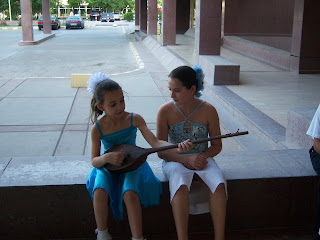
It is a beautiful Spring day here in Almaty, and I decided to take a break from reading through vast piles of reports on the educational system and take a walk. Normally, I explore different parts of the city or go to one of the many parks around my house. Today I decided to do something a little different and took the bus to the base of Kok Tobe (literally, Green Hill), which is where the television tower is located. It is about a 20 minute walk up a rather steep slope to reach the top, and I spent about an hour walking around and taking pictures of the city. It is amazing to see the mountains rising above Almaty while a layer of smog hovers over the valley! As I was wandering around (clearly looking like a foreigner in an outfit thrown together solely for the purpose of walking--since it was early and no one was likely to be around on Kok Tobe), one of the security guards insisted on taking my picture with some of the more popular statues in the area--the rather effeminate looking Beatles.









.JPG)
.JPG)
.JPG)
.JPG)
.JPG)
.JPG)
.JPG)
.JPG)

.JPG)
.JPG)
.JPG)

.JPG)
.JPG)













.JPG)
.JPG)
.JPG)





